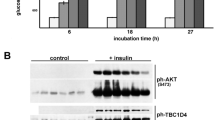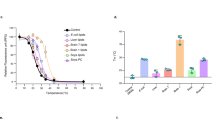Abstract
The uptake of glucose into mammalian cells, catalysed by members of the GLUT family of glucose transporters, is regulated by a variety of hormones, growth factors and other agents. In adipocytes, skeletal muscle and heart the principal regulator is the hormone insulin, which rapidly stimulates glucose uptake by bringing about the translocation of the GLUT4 glucose transporter isoform from an intracellular vesicular compartment to the cell surface. Recent studies have implicated theC-terminal hydrophilic region of this protein as being primarily responsible for its insulin-regulated trafficking. In an attempt to identify the protein machinery involved in this trafficking, we have used glutathione S-transferase fusion proteins bearing hydrophilic domains of various GLUT transporters in affinity purification experiments on detergent-solubilized extracts of 3T3-L1 adipocyte intracellular membranes. TheC-terminal region of GLUT4 was found specifically to bind a number of polypeptides in these extracts, which are therefore candidates for components of the trafficking machinery. Although these proteins did not bind to the corresponding region of the more widely-distributed GLUT1 glucose transporter isoform, regulation of this transporter also appears to be of physiological importance in some cell types. To study such regulation we have used as a model system the interleukin-3 (IL-3)-dependent haemopoietic cell line IC.DP. These cells express a temperature-sensitive mutane of thev-abl tyrosine kinase, whose activation at the permissive temperature permits cell survival in the absence of IL-3 by suppression of apoptosis, although the growth factor is still required for proliferation. Both IL-3 and activation of the kinase were found to stimulate glucose transport by promoting the translocation of GLUT1 to the cell surface. Moreover, inhibition of glucose uptake by addition of transport inhibitors markedly increased the rate of apoptosis, an effect which could be reversed by the provision of alternative energy sources. These observations suggest that the trafficking of GLUT1, regulated by growth factors or oncogenes, may play an important role in the suppression of apoptosis in haemopoietic cells.
Similar content being viewed by others
References
Baldwin, S. A. (1994)Cell Physiol. Biochem. 4:242–264.
Baldwin, S. A., Kan, O., Whetton, A. D., Martin, S., Fawcett, H. A. C., Flint, D. J. and Wilde, C. J. (1994)Biochem. Soc. Trans. 22:814–817.
Barros, L. F., Baldwin, S. A., Jarvis, S. M., Cowen, T., Thrasivoulou, C., Beaumont, N. and Yudilevich, D. L. (1992)J. Physiol. (Lond). 446:345P.
Barros, L. F., Marchant, R. B. and Baldwin, S. A. (1995a)Biochem. J. 309:731–736.
Barros, L. F., van den Berghe, N., Nixon, G., Griffiths, M., van Mackelenbergh, M., Ingram, J. and Baldwin, S. A. (1995b)Biochem. Soc. Trans. 23:414S.
Brown, S. J., Gould, G. W., Davies, A., Baldwin, S. A., Lienhard, G. E. and Gibbs, E. M. (1988)Biochim. Biophys. Acta 971:339–350.
Clarke, J. F., Young, P. W., Yonezawa, K., Kasuga, M. and Holman, G. D. (1994)Biochem. J. 300:631–635.
Corvera, S., Chawla, A., Chakrabarti, R., Joly, M., Buxton, J. and Czech, M. P. (1994)J. Cell Biol. 126:979–989.
Dick, A. P. K., Harik, S. I., Klip, A. and Walker, D. M. (1984)Proc. Natl. Acad. Sci. USA 81:7233–7237.
Evans, C. A., Owen-Lynch, P. J., Whetton, A. D. and Dive, C. (1993)Cancer. Res. 53:1735–1738.
Hakes, D. J. and Dixon, J. E. (1992)Anal. Biochem. 202:293–298.
Haney, P. M., Levy, M. A., Strube, M. S. and Mueckler, M. (1995)J. Cell Biol. 129:641–658.
Kan, O., Baldwin, S. A. and Whetton, A. D. (1994)J. Exp. Med. 180:917–923.
Kasanicki, M. A., Cairns, M. T., Davies, A., Gardiner, R. M. and Baldwin, S. A. (1987)Biochem. J. 247:101–108.
Kipreos, E. T. and Wang, J. Y. J. (1988)Oncognene Res. 2:277–284.
Owen, P. J., Musk, P., Evans, C. A. and Whetton, A. D. (1933)J. Biol. Chem. 268:15696–15703.
Shepherd, P. R., Nave, B. T. and Siddle, K. (1995)Biochem. Soc. Trans. 23:S201.
Shetty, M., Loeb, J. N., Vikstrom, K. and Ismailbeigi, F. (1993)J. Biol. Chem. 268:17225–17232.
Slot, J. W., Geuze, H. J., Gigengack, S., Lienhard, G. E. and James, D. E. (1991)J. Cell Biol. 113:123–135.
Takata, K., Kasahara, T., Kasahara, M., Ezaki, O. and Hirano, H. (1990)Biochem. Biophys. Res. Commun. 173:67–73.
Verhey, K. J. and Birnbaum, M. J. (1994)J. Biol. Chem. 269:2353–2356.
Whetton, A. D., Brazill, G. W. and Dexter, T. M. (1984)EMBO J. 3:409–413.
Yang, J. and Holman, G. D. (1993)J. Biol. Chem. 268:4600–4603.
Author information
Authors and Affiliations
Rights and permissions
About this article
Cite this article
Baldwin, S.A., Barros, L.F. & Griffiths, M. Trafficking of glucose transporters-signals and mechanisms. Biosci Rep 15, 419–426 (1995). https://doi.org/10.1007/BF01204346
Received:
Issue Date:
DOI: https://doi.org/10.1007/BF01204346




